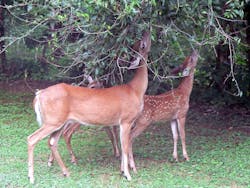Transportation officials throughout the country are warning drivers to be extra cautious to avoid collisions with deer. An increase in deer-related crashes is likely during the months of October through December due to deer mating and hunting season.
“Deer pose a danger to motorists throughout the year, but especially in the fall,” Tennessee Highway Patrol Colonel Tracy Trott said. “November is typically the worst month for deer-related crashes. It is important to exercise caution, slow down and stay alert in areas where deer are populated.”
Deer-vehicle crashes (DVCs) in the United States are a “significant and increasing
transportation safety problem,” according to the Deer-Vehicle Crash Information Clearinghouse. According to the National Highway Traffic Safety Administration, there are about 1.5 million vehicle accidents with deer each year that kill more 200 Americans and result in more than $1 billion in vehicle damage.
State Farm Insurance has been studying DVCs involving the company’s clients since 2004. The insurer has found that the majority of accidents occur in October through November, with the highest incidence in November. State Farm estimates 1.09 million collisions between deer and vehicles occurred in the U.S. between July 1, 2010 and June 30, 2011.
State Farm also reported that West Virginia topped the list of states where a driver is most likely to run into a deer for the fifth year in a row in 2010. The other states in the top 10 in 2010 were Iowa, South Dakota, Pennsylvania, Michigan, Montana, Wisconsin, Minnesota, North Dakota and Wyoming.
However, drivers should be alert to the increased chance of a deer encounter on the highway everywhere, especially for the next several weeks.
To avoid vehicle-deer collisions, State Farm and the Department of Safety and Homeland Security Resources Agency suggest the following tips to help prevent deer-related crashes during peak mating and hunting seasons:
- Remember that mating season puts deer on the move and deer tend to move at dawn and dusk.
- Whenever you see deer cross the road, expect more to follow. Many times, the second or third deer crossing becomes the one that motorists hit.
- Be attentive; drive defensively, constantly scanning the roadside, especially at daybreak and dusk.
- Do not swerve to avoid contact with deer. This could cause the vehicle to flip or veer into oncoming traffic, causing a more serious crash. Swerving also can confuse the deer as to where to run.
- When you spot a deer, slow down immediately. Proceed slowly until you pass that point.
- If you do collide with a deer, never approach the injured animal. They are powerful and can cause bodily harm to a human. Report any deer collision, even if the damage is minor.
- Be aware of posted deer crossing signs. These signs are placed in known active deer crossing areas.
- Be aware that deer are most active during the evening, between 6 and 9 p.m.
- At night, use high-beam headlamps as much as possible to illuminate the sides of the road where deer can linger.
- Do not rely on vehicle-mounted “deer whistles.” Studies have shown deer are not affected by this deterrence method.
